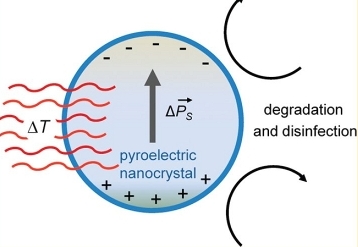LiNbO3 (LN) and LiTaO3 (LT) materials of polar crystal structure exhibit a spontaneous polarization that can be changed by temperature. This phenomenon, commonly known as the pyroelectric effect, leads to the generation of surface charges that in turn are the source for a pyroelectrocatalytic or pyroelectrochemical activity of these materials described in this paper. It can also be regarded as a selective conversion of thermal via electrical to chemical energy based on the pyroelectric effect. In this context, we have investigated the impact of thermally excited pyroelectric LN and LT nano- and microcrystalline powder materials on the bacterium Escherichia coli in aqueous solutions. Powders have been prepared both by milling of commercially available single crystals and by precursor-based solution routes. Our results show that in dependence on the crystallite size and surface area of the pyroelectric particulate material in direct contact with the cells and/or their culture solution, a high antimicrobial activity can be achieved. On the basis of further experimental results of oxidative conversion of the fluorescent dye 2',7'-dichlorofluorescin, a disinfection mechanism including the formation of reactive oxygen species at the pyroelectric particle surface is proposed. The phenomenon is discussed in analogy to the well-established photocatalytic disinfection mechanism.

LiNbO3 (LN) and LiTaO3 (LT) materials of polar crystal structure exhibit a spontaneous polarization that can be changed by temperature. This phenomenon, commonly known as the pyroelectric effect, leads to the generation of surface charges that in turn are the source for a pyroelectrocatalytic or pyroelectrochemical activity of these materials described in this paper. It can also be regarded as a selective conversion of thermal via electrical to chemical energy based on the pyroelectric effect. In this context, we have investigated the impact of thermally excited pyroelectric LN and LT nano- and microcrystalline powder materials on the bacterium Escherichia coli in aqueous solutions. Powders have been prepared both by milling of commercially available single crystals and by precursor-based solution routes. Our results show that in dependence on the crystallite size and surface area of the pyroelectric particulate material in direct contact with the cells and/or their culture solution, a high antimicrobial activity can be achieved. On the basis of further experimental results of oxidative conversion of the fluorescent dye 2',7'-dichlorofluorescin, a disinfection mechanism including the formation of reactive oxygen species at the pyroelectric particle surface is proposed. The phenomenon is discussed in analogy to the well-established photocatalytic disinfection mechanism.
